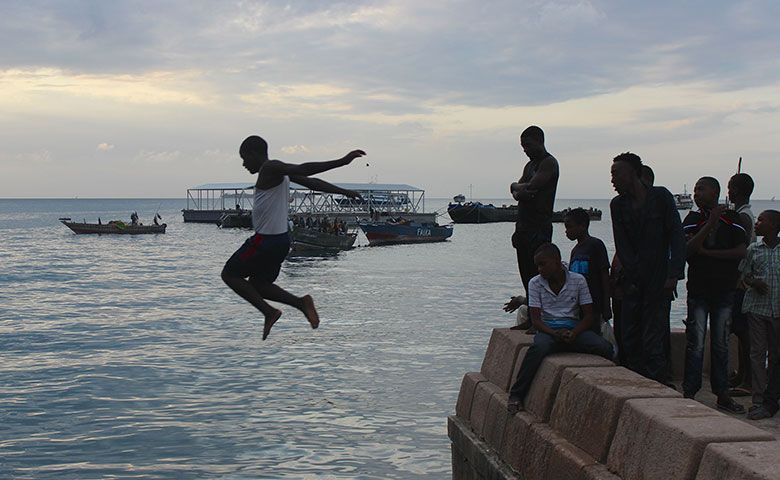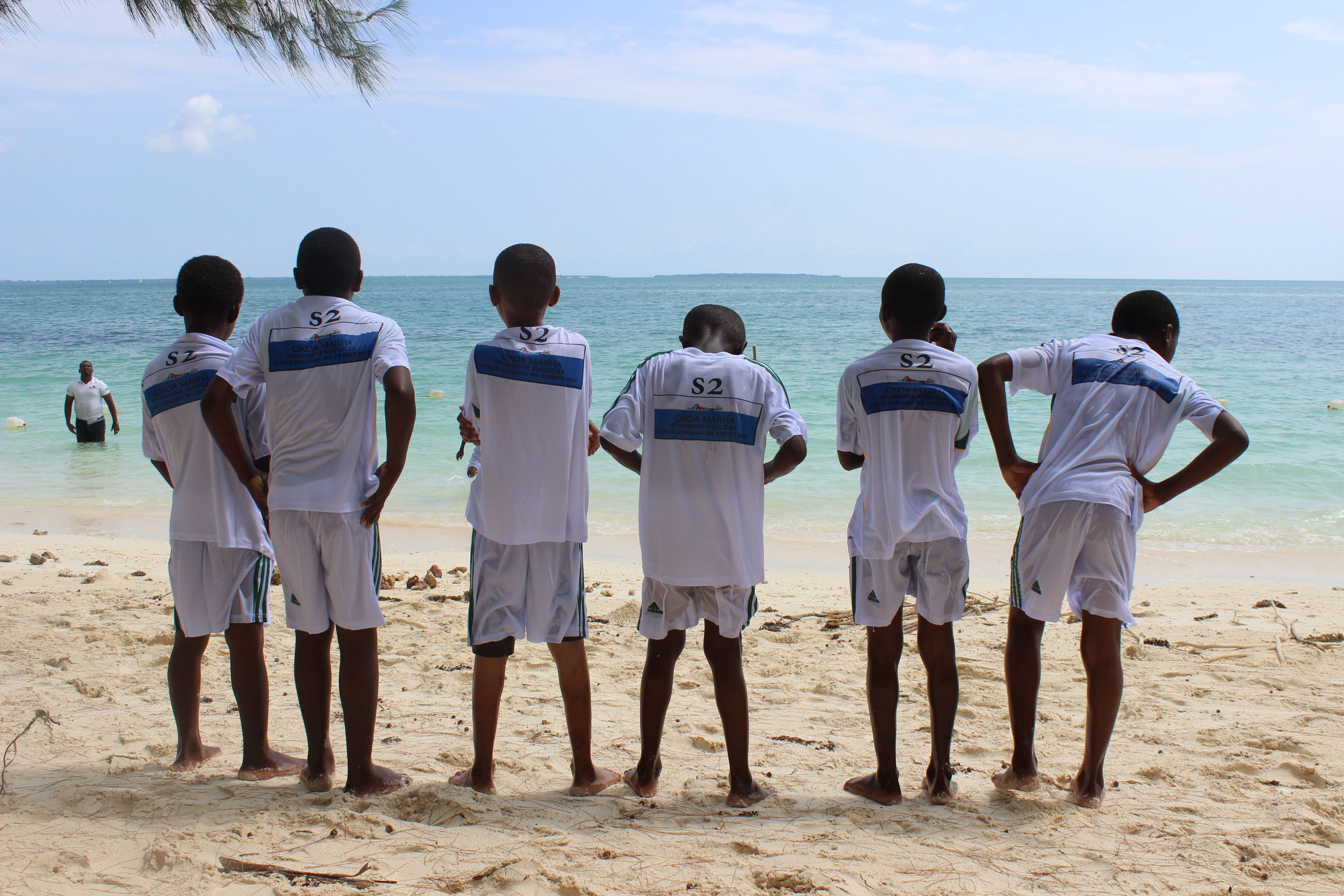In Stone Town, Zanzibar, jumping off the seawall at Forodhani Gardens into the ocean is an evening ritual for boys. Though many have been doing it for years and are experienced swimmers, performing the act has its risks.
“Just this week someone drowned in Forodhani—a boy,” says Bakhtim Marshed, co-founder of the Panje Project, an NGO in Zanzibar that focuses on education and training for youth.
Zanzibar sits less than 50 miles off the coast of northeastern Tanzania and comprises a pair of islands, Unguja and Pemba. And on these small landmasses, where beach is ubiquitous, the risks of drowning are just as commonplace.
What exactly happened during this particular incident Marshed didn’t know: there are a number of possibilities. Tides change swiftly throughout the day and over the course of the month, so recognizing the true depth of the water at all times can be difficult. Even for someone who isn’t taking dives into the ocean, accidents can easily occur, as no wall or barrier exists between Forodhani’s plaza and the water several meters below.
Globally, the annual death toll due to drowning surpasses 350,000 people. In areas where Muslim religious culture is prevalent, like Zanzibar, many girls never learn basic swimming skills. In Bangladesh, drowning is the cause of more than 40% of deaths among children aged 1 to 4. And in China, it’s the leading cause of injury death for children up to the age of 14.
According to a 2014 World Health Organization (WHO) report, though, drowning lacks the attention that other public health threats receive. In the report, the first of its kind published by the organization, the WHO stresses the need for improved data. Experts suggest current data may significantly underestimate the actual number of drowning incidents in both high-income and low-income countries, since statistics exclude drownings from floods and water transport disasters. Additionally, non-fatal drowning incidents, which can offer helpful information towards drowning prevention, are often not well-catalogued.
Marshed’s NGO, the Panje Project, has taken up a small role tackling this overlooked issue. With funding and training support from UK-based charity Royal National Lifeboat Institute (RNLI), Panje has been offering an aquatic survival program to children on northern Unguja since late 2013.
"We’re kind of testing the model at the moment to see whether we can take an organization that previously had no background in teaching swimming whatsoever and give them the skills and knowledge that they need to run a swim teaching program," says Tom Mecrow, program manager for RNLI's work in Zanzibar.
The program has been running primarily in the town of Nungwi, on the northern tip of Unguja where the Panje Project is based, and recruits kids between the ages of 7 and 14 from the local primary and secondary schools. In batches of 20, the children attend 2-hour training sessions each day for 15 days and about 70% of the kids who come through the program pass, according to Mecrow.
During those 2 weeks, the kids learn a slew of survival skills besides swimming: properly checking for sharp rock or urchins in the water, saving others using a stick or rope, floating on their backs and rolling from their fronts to their backs.
“They need this, as long as we’re living on an island like this one,” says Marshed.
Panje has taught 300 children and now the program is expanding to other coastal villages in northern Unguja. Operations are still small for Panje’s swim program, though, so Mecrow and Marshed are just in the first steps of taking on the problem of limited data in Zanzibar.
"What we haven’t tried to do yet is to look at whether or not rates of drowning have reduced…to do that would require a fairly big longitudinal study," Mecrow says.
While experts on drowning may not be certain about the numbers around the globe, they do know a lot about causes. Mecrow, who worked on drowning prevention in Bangladesh, Sudan and South Africa before focusing on Zanzibar, says in areas with high rates of drowning, there’s no direct correlation with swimming capabilities: the majority of people are natural learners and many take on the skill without any formal lessons before the age of 10.
“Most people they know how to swim here; they teach themselves,” says Marshed. “The other thing we teach is to control yourself in water. It’s different. It’s more skilled.”
11-year-old Nassor Mtumwa of Nungwi Primary School says that it was when he came to Panje’s program that he learned to swim. But it’s possible Mtumwa already knew the basics and has a different idea of what swimming means now that there are a number of other skills involved.
“I know how to do land-based rescue, like with a rope,” says Mtumwa, who completed the training last summer.
RNLI has coached Panje’s 8 swim instructors to teach these simple rescue techniques because basic knowledge of swimming is not the biggest problem. The organizations also provide community education through an initiative called “Water Safety Messages,” which is carried out in local schools, to address other causes.
"It's about looking at other things ... you know ... childhood supervision, and water safety education for mothers and for parents, creating barriers to water, so there’s lots of different ways to mitigate drowning,” says Mecrow. “Swimming teaching is just one of them."
This goes for other places around the world, too. In Bangladesh, child development centers known as anchals were established to improve supervision of toddlers in rural areas. In a study by the Center for Injury Prevention and Research, Bangladesh, data shows children who participated in the anchal programs were 82% less likely to drown.
For girls in Zanzibar, the biggest hurdle may still be acquiring basic swimming skills. 98% of the population on the islands are Muslim, according to US government data, and religious culture steers women away from the activity, since the typical bathing suit is form-fitting and offers less coverage of the body.
In Nungwi, providing community leaders with a specially-designed bathing costume that covered girls’ bodies and hair was enough to get their approval. Some sessions even draw more girls than boys, says Marshed.
"Some parents they’re against it for religious reasons...” says Mecrow. “In the new areas that we’re going to we’re facing quite significant initial challenges in terms of getting girls on board."
Those challenges are evident in Kendwa, one of the villages where the program is expanding. On the first day of swim survival lessons for two groups of children from the local primary school, Marshed’s team collected permission slips from 38 boys but no girls, as community leaders have not yet agreed to let girls participate in the trainings.
Despite the low number of girls who have swimming experience compared to boys, males are twice as likely to drown as females, according to the WHO. An estimated 11,203 deaths by drowning among boys aged 15-24 years occurred in WHO’s African region in 2012; the estimate for girls of that same age group was 3,447 deaths. The boys filling the Panje Project’s classes are just a couple years away from entering the most at-risk group.
Although Panje Project coordinators and RNLI representatives like Mecrow are providing skills they feel are critical for island residents, they are also adamant that community members decide for themselves what they want out of the program, who they want to participate, or if they even want the program at all.
Marshed says women who spend time fishing in water have asked if the Panje program is open to adults, so Panje and RNLI are working on offering classes to an older age group as well. Being in water is often recreational for younger island residents, but once they grow a bit older, it can be much more.
“In Zanzibar it’s constant interaction,” says Mecrow. “Because kids are playing in the water, [people] are fishing in the water, they’re washing dishes in the water, they’re washing their clothes in the water, they’re bathing in the water, they’re using it for transportation from one island to the other.”





